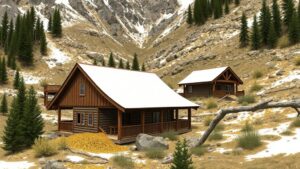Breaking Down Treasure Hints That Reference Natural Formations
Breaking Down Treasure Hints That Reference Natural Formations
The allure of treasure hunting captivates individuals across various backgrounds, fueled by the promise of discovery and fortune. A key aspect of this pursuit involves interpreting clues associated with natural formations. Understanding how to decode these hints not only enhances the thrill of the hunt but also promotes a deeper appreciation of the geography involved. In this article, we will explore how to analyze treasure hints that reference natural formations, providing tools and knowledge to navigate this fascinating landscape.
The Importance of Natural Formations in Treasure Hints
Natural formations, such as mountains, rivers, valleys, and geological structures, often serve as vital indicators in treasure maps or riddles. They can mark locations or offer contextual clues about nearby treasures. For example, in many historical treasure hunts, references to a great mountain or river winding like a serpent are common. Here, knowledge of local geography is crucial. Clues tied to specific formations can hinge on both physical characteristics and cultural significance.
Decoding Clues Related to Geological Features
Geological features, including rock formations, minerals, and terrain types, often play a central role in treasure hunting. Clues may describe characteristics like the color of rocks or specific alignments with other natural elements.
- Type of Rock – Different types of rocks, such as granite, limestone, or sandstone, can influence the location of hidden treasures. For example, a clue referencing the rock that touches the clouds may point to a uniquely tall granite peak, suggesting a search area around its base.
- Stratification – Many layers in rock formations may hint at historical events, including the burial of treasures. Clues like buried under three levels of earth can refer to mining activity or erosion processes that exposed treasures over time.
Consider the case of the famed Lost Dutchman Gold Mine in Arizona, which is often linked to specific geological features like the Superstition Mountains. Treasure seekers have long utilized descriptions of these mountains–marked by their distinct profiles and mineral deposits–to locate the elusive gold mine.
Utilizing Hydrological Clues
Watercourses, including rivers and streams, frequently serve as reference points in treasure hunting. Clues may indicate proximity to water or describe the peculiarities of water bodies.
- Flow Direction – Descriptions such as upstream from a forked river can indicate a precise location by providing the orientation of the search. Understanding river dynamics–how they erode landscapes or create features–can provide insight into the probable areas where treasures might be hidden.
- Natural Instream Features – Locations where natural formations create pools or eddies can signal areas where treasures could settle. Legacy hints might say, beneath the stone arch by the clear waters, hinting at a specific geological formation alongside a water body.
An example can be drawn from the historical accounts of explorations along the Old Spanish Trail, where treasure hunters were able to find valuable artifacts by closely examining the hydrology of the areas they traversed.
Tree and Flora References in Treasure Hints
Natural flora, including trees and bushes, often appear in treasure clues, serving as landmarks or markers. Trees can provide specific identifiers due to their size, species, or unusual features.
- Unique Characteristics – Hints may reference trees that are twisted like a serpent or the ancient oak that stands alone. Such descriptions can denote specific trees known within a region, thus guiding treasure hunters toward their search area.
- Ecological Relationships – Clues may also weave in details about surrounding flora and fauna. For example, a riddle that mentions where the wildflowers bloom in harmony with the old pine can impart information about high moisture levels and nutrient-rich soils, which could indicate burial sites from past human settlements.
The case of the Dungeness Crab Tree in Washington serves as a practical example; hunters succeeded in uncovering treasures by following clues pertaining to the unique tree formations in that area.
Assessing Topographical Features as Clues
Topographical elements such as hills, valleys, and depressions can also serve as vital clues in treasure hunting. These cues often relate to the shape and contour of the land.
- Elevation and Decline – Hints may include terms like at the low point between the two hills. Understanding the topographical layout is essential for navigating hidden valleys or depressions commonly overlooked.
- Landforms and Patterns – Maps with contour lines and elevation markers are invaluable. Recognizing patterns can assist in interpreting hints like where the earth rises like a great wave, common in geographical riddles that describe hills or rises.
A real-world case can be observed in the exploration of the Applegate Trail, where treasure seekers utilized a combined understanding of elevation changes and natural landmarks to discover items left by traders and explorers.
Conclusion: Actionable Takeaways
Breaking down treasure hints referencing natural formations involves a multidisciplinary approach, combining geography, geology, and ecological understanding. By focusing on specific features–whether rocks, rivers, trees, or topographical shapes–treasure hunters can enhance their search strategies. Here are key takeaways to employ:
- Study local geography to familiarize yourself with natural landmarks.
- Interpret clues through a geological lens, considering rock types and formations.
- Understand hydrological features and their significance in indicating treasure locations.
- Be mindful of ecological systems and how they relate to the clues provided.
- Use topographic maps to aid in visualizing and navigating the landscape.
By implementing these strategies, treasure hunters can increase their chances of uncovering hidden riches, turning the thrill of the hunt into a rewarding adventure.

